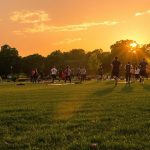
The recognized advantages of participation in physical activity and exercise have existed for a much longer timespan than many are aware. Our forebears from the Paleolithic era routinely took part in physical exercise in order to live. Rather than pursuing soccer for victory or relishing a walk through a shaded alley, they “exercised” by being in pursuit of their next meal. For them, no exercise meant no food. How’s that for a health benefit?
With the commencement of stationary farming about 10,000 years ago, it was no longer necessary to achieve top efficiency. As our predecessors continued to come up with increasingly advanced ways of obtaining food, their level of physical activity decreased. It was the ancient Greek doctor Herodicus in the 4th century BCE who figured out how important it was to stay active in a culture that was not that of hunters and gatherers. He used gymnastic remedies, a kind of Greek medical care that was based on strong physical activity as a form of healing. During that same time period, Hippocrates, who is often referred to as the Father of Modern Medicine, asserted, “If we could give every individual the right amount of nourishment and exercise, not too little and not too much, we would have found the safest way to health.” In the 12 century CE, the Jewish philosopher Rabbi Moses ben Maimon, a physician to the Sultan of Egypt, stated, ”Anyone who lives a sedentary life and does not exercise, even if he eats good foods and takes care of himself according to proper medical principles, all his days will be painful ones and his strength will wane.” The 15th-century theologian and scholar Robert Burton went so far as to declare that not exercising, or “idleness” as he referred to it in his widely read tome, The Anatomy of Melancholy, was the “bane of body and mind.” Burton also warned that the lack of exercise was the sole cause of melancholy (the name given depression at that time) and “many other maladies.” Burton claimed that idleness was one of the seven deadly, as well as “the nurse of naughtiness,” and the “chief author of mischief.” For Burton, exercise was not only essential for good health but a means of avoiding eternal damnation.
By the 1500s, the advantages of regular physical activity were commonly acknowledged by affluent and well-informed individuals, who could afford to have spare time. During this time period, H. Mercuralis characterized exercise as “intentional and arranged activity of the human body, breathlessness included, and done to achieve health or physical fitness” and this explanation is still a standard today.
Group games and activities offer more than just physical health benefits; they also have positive effects on emotions. The earliest known team sport was the Ball Game, which was established by the Ancient Mayans. There were two squads vying to get a ball through a hoop placed roughly 23 feet off the ground on the wall. The regulations were to get the ball into the basket with specific body parts. In some instances, the manager of the team that came out on the losing end would offer himself up as a sacrificial offering to the successful team, a gesture thought to be imperative for attaining success by the Mayans.
Native Americans are said to be the inventors of the contemporary sport of lacrosse, as well as a variety of other stick activities. This sport named by French settlers was more than just a way to have fun. This cultural event was utilized as a means of resolving conflicts between various tribes.
Looking back, the advantages of physical activity that were seen by Herodicus and the Native Americans have remained almost unchanged. Growing evidence is backing up previous claims that staying physically active is necessary for maintaining health and well-being. Sports are an essential part of culture that helps to shape the development of both children and adults. It is beyond dispute that doing exercises on a regular basis contributes to the good functioning of the brain, heart, skeletal and muscular systems. Getting physical activity can also lessen the chances of developing serious illnesses like cancer, diabetes, and obesity. Working out on a regular basis can enhance one’s mental health and total satisfaction.
What Are Physical Activity And Exercise?
Any type of activity that requires the use of skeletal muscles and requires energy expenditure with the purpose of improving health is known as physical activity. The advantages of good health are a lower blood pressure, a healthier level of lipids in the blood, and better heart health. Doing physical activities such as gardening, tidying up the house, playing with your pet, or using the stairs rather than an elevator are all consider appropriate forms of exercise. Exercising does not have to be done in one big chunk of time. It can be built up over the course of the day through different activities. While tapping out text on a cellphone, laptop, or playing video games engages skeletal muscle and requires a minimal amount of energy, it is not substantial enough to benefit your overall health.
Despite being aware that exercise is beneficial to individuals’ wellbeing, the amount of physical activity among Americans is still lower than the desired level. The Surgeon General’s physical activity guidelines are met by just 21% of all American adults, according to data from the Center for Disease Control. Fewer than 30% of high schoolers get an hour or more of physical activity in a day. Non-Hispanic whites display a higher level of activity than Hispanics and Blacks, which also applies to both males and females, with 54% of males being active and 46% of females being active. Those who have had more schooling and those in households that earn more than the poverty threshold are more likely to be engaging in physical activity.
The term “exercise” is sometimes used as another word for “physical activity,” but it actually refers to a specific type of physical activity. Doing exercise which is arranged, organized, and methodical can help with improving physical fitness. As an added bonus, there is a dramatic improvement in overall health. Enhancing one’s physical fitness can cause an increase in the efficiency with which the heart circulates blood, increased mass in the muscles, and enhanced suppleness.
Principles Of Adaptation To Stress
The human body adapts well when exposed to stress. Strain is a notion used in the realm of exercise, which refers to an activity higher than the typical day-to-day operation. Each person’s source of stress is different and depending on their physical fitness, the amount of stress can differ. For instance, a secretary who passes their time at a desk may put their heart and lungs to the test simply by climbing several sets of stairs. For a committed runner, strength training may present their muscles to contractions that they are not familiar with.
Every person experiences different levels of stress, but there is an accepted standard of exercising that can assist people in controlling the amount of pressure they are subjected to, thereby preventing harm and making the most of their body’s capacity to adapt. Gaining understanding of these concepts can be beneficial in creating an efficient fitness regimen.
Overload Principle
The popular phrase “No pain, no gain” suggests that working out must be agonizing in order to be effective. Is this true?
Absolutely not. It would not be as enjoyable if that was the case. It is possible to convey the same point in a different way by stating that progress occurs due to pressure. Engaging in physical activity like walking or jogging puts additional strain on the controllers of higher heart rates, blood pressure, energy production, respiration, and sweating to control body temperature. As subsequent adaptations take place, the unease that was present when initially participating in the same activity will seem to have lessened over time. The overload principle necessitates that in order for the system to evolve and develop, it must be exposed to increased stressors. This is an effect of the adaptation.
As an example, a novice weightlifter does 10 squat exercises using a weight of 150 pounds. After two weeks of handling this weight, the lifter can see that the 150 pounds is less challenging to lift and less draining once it has been done. The lifter increases the weight by 20 pounds, making the total weight to lift now 170 pounds. The strength of the lifter will only go up until the point at which their limit has been hit or the amount of exertion doesn’t change; afterwards the lifter’s strength will stay the same. The same idea can be used to not only build muscular power, but also to develop suppleness, muscle stamina, and cardiovascular stamina.
FITT
The amount of pressure that physical activity puts on the body can be monitored by four factors: How often, how extreme, how long, and what kind. The American College of Sports Medicine (ACSM)’s FITT principle is a subset of the general overload concept.
Frequency and Time
Frequency indicates the amount of times an exercise is executed over a certain amount of time. The quantity of walks and jogs that would be done in the course of a week is generally established. A novice may decide that exercising twice to three times every week is enough to provoke progress. A knowledgeable expert may discover that 2–3 days doesn’t provide enough of a challenge for the system. An increase in conditioning necessitates greater difficulty in order to keep up the progress and to prevent stagnation.
How long you work out impacts the level of strain endured while performing physical exercise. Walking for a half hour at a quick pace is less taxing for your body than running a marathon that lasts for four hours.
Frequency and time are separate but are usually referred to together as volume. It is believed that a larger amount of stress is better represented by an increase in volume. This can be connected to the progression principle. For example, when attempting to create a jogging plan, you may organize 2 weeks like this:
- Week 1: three days a week at 30 minutes per session
- Week 2: four days a week at 45 minutes per session
Type of Exercise
One could say that an individual’s workout should be tailored to their desired outcome. The goal of exercise in regards to cardiorespiratory fitness is to activate the heart/lung system. Doing other physical activities that have the same outcome count as well, such as going swimming, biking, grooving, cross-country skiing, taking up some aerobic classes, and many more. Therefore, by engaging in these activities one can strengthen the lungs and promote better functioning of both the cells and heart.
However, the more specific the exercise, the better. Although ballroom dancing can be useful for increasing cardiorespiratory fitness, it’s not likely to have an effect on one’s 10k run time. Athletes who are preparing for a 10k event focus the majority of their training on running, as that is what they will ultimately be doing in the 10k. These athletes understand how valuable it is to practice in such a way that their bodies can develop. The principle of specificity must be taken into account when devising an exercise regimen.
Intensity
The level of difficulty with which the physical activity is performed is the most essential part of the FITT program. The major factor that leads to adaptation is intensity rather than any other elements. It is essential for people who are beginning to exercise to measure the intensity, not simply guess it as very difficult, straightforward, or somewhere in between. This number will not only give insight into how hard someone is working out, but will also help to create workout plans to fit people’s individual goals.
How then can intensity be measured? Measuring a person’s heart rate is a great way to determine how much effort they are putting into their cardiorespiratory fitness. Calculating a certain proportion of the highest load possible would be the criterion employed for strength training.
Rest, Recovery, and Periodization
For centuries, athletes have had to manage the fine line between rigorous exercise, progress in their performance, and taking the necessary amount of rest. The rule of rest and regeneration indicates that the amount of rest taken to recuperate from the strain of physical exercise should be in proper balance in order to avoid excessive tension. Organizing progressive fitness training into blocks of time is a strategy being used by both athletes and exercise scientists to make sure they are getting sufficient rest and recovery. By giving the athlete adequate rest, they can maintain their performance without over-exerting themselves. Periodization, a training technique important to athletes looking to take their game to the next level, can also be implemented into most exercise regimens. The idea of periodization implies that exercise programs involve cycles of strain followed by periods of recovery.
Reversibility
Chronic adaptations are not permanent. As the saying goes, “Use it or lose it.”
The rule of reversibility states that in order to maintain the same level of adjustment, activity must be retained at the same rate. As activity declines, called detraining, adaptations will recede.
When it comes to cardiopulmonary stamina, essential metrics like VO2max, stroke volume, and cardiac output all decreased in the process of detraining, while the submaximal heart rate surged. In a single experiment, those who had been taught were granted 20 days of inactivity in their beds. Once the period of rest concluded, the oxygen uptake capacity decreased by 27% and the stroke volume and heart output dropped by 25%. The most highly skilled individuals in the research had to practice for close to 40 days after the period of rest in order to return to their original status prior to the rest period. After examining a group of collegiate swimmers, the research found that lactic acid levels in the bloodstream following a 2 minute swim dramatically increased by over 100% in only 4 weeks of detraining, indicating an immense decline in the body’s capacity for buffering lactic acid.
The effects of not training show up in not just endurance, but also muscular strength, muscular endurance, and flexibility.
Individual Differences
Although the foundations of dealing with stress are relevant to all people, not all individuals will have the same reaction to it. Families comprised of a father, mother, and 3 children took part in a 20-week-long program as a part of the HERITAGE Family investigation. They did physical activity 3 times a week, working out at 75% of their maximal oxygen uptake, and gradually extended their time to 50 minutes through the 14th week. At the end of the research, individuals and families showed a large difference in reactions to the same exercise plan. The individuals that experienced the most transformation also had similar proportional increases inside their family, and the reverse was true. Studies conducted have led researchers to come to the conclusion that variances in reactions to exercise are due to genetics. It is estimated by certain specialists that genetics can play up to 47% of a role in the success of an individual’s training.














